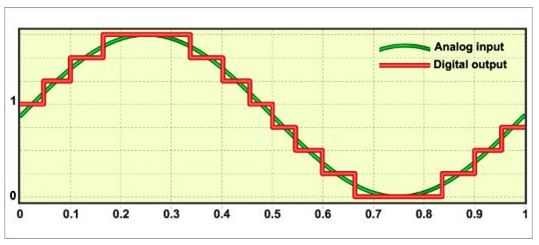What is ADC? Analog-to-digital converters, abbreviated as “ADCs,” work to convert analog (continuous, infinitely variable) signals to digital (discrete-time, discrete-amplitude) signals. In more practical terms, an ADC converts an analog input, such as a microphone collecting sound, into a digital signal.
An ADC performs this conversion by some form of quantization – mapping the continuous set of values to a smaller (countable) set of values, often by rounding. As a result, the analog-to-digital process will always involve a certain amount of noise or error, however small.

Different types of converters achieve this quantization in different ways, depending on their architecture. Each ADC architecture has its own distinct strengths and weaknesses.
ADC Performance Factors
We can evaluate ADC performance using several factors, the most important of which are:
ADC Signal-to-noise ratio (SNR): The SNR reflects the average number of non-noise bits in any particular sample (effective number of bits or ENOB).
ADC Bandwidth: We can determine bandwidth by evaluating the sampling rate – the number of times per second the analog source is sampled to generate discrete values.
ADC Comparison – Common Types of ADC
Flash and Half (Direct Type ADC): Flash ADCs, also called “direct ADCs” are very fast—capable of sampling rates in the gigahertz range. They achieve these speeds by running a bank of comparators that operate in parallel, each for a defined voltage range. As a result, they tend to be large and expensive compared to other ADCs. They require 2N-1 comparators, where N is the number of bits (8-bit resolution, therefore, requires 255 comparators). You can find flash ADCs at use in video digitization or fast signals in optical storage.
Semi-flash ADC: Semi-flash ADCs work around their size limitation by using two separate flash converters, each with a resolution of half the bits of the semi-flash device. One flash converter handles the most significant bits while the other handles the least significant bits (reducing the components to 2*2N/2-1, resulting in 8-bit resolution with 31 comparators). On the other hand, semi-flash converters take twice as long as flash converters, though they are still very fast.
Successive Approximation (SAR): We can identify these ADCs by their successive approximation registers, which gives them the nickname SAR. These ADCs use a comparator to compare input voltage and the output of an internal digital-to-analog converter, successively judging whether the input is above or below a narrowing range’s midpoint. For example, a 5V input signal is above the midpoint of a 0 – 8V range (midpoint is 4V). Therefore, we compare the 5V signal to a range of 4-8V, found to be below the midpoint of the range. Continue this process until the resolution maxes out or you achieve the desired resolution. SAR ADCs are considerably slower than flash ADCs, but they offer higher possible resolutions without the component size and cost of flash systems.
Sigma-Delta ADC: ΣΔ is a relatively recent ADC design. Sigma Deltas are very slow compared to other designs but offer the highest resolution of all ADC types. As a result, they are very well-suited to high-fidelity audio applications, but they’re typically not usable where more bandwidth is necessary (such as video).
Pipelined ADC: Pipelined ADCs, also called “subranging quantizers,” are similar in concept to SARs, but more refined. While SARs progress through each step by going to the next most significant digit (sixteen to eight to four and so on), the pipelined ADC uses the following process:
1. It performs a coarse conversion.
2. It then compares that conversion to the input signal.
3. The ADC performs a finer conversion, allowing for an interim conversion of a range of bits.
Pipelined designs typically offer a middle ground between SARs and flash ADCs, balancing speed, high resolution and size.
Summary
Additional types of ADCs exist – such as ramp-compare, Wilkinson, integrating, and more – but the ones in this article are those most commonly used in consumer electronics and available for sale to the general population. Depending on the type, you may find ADCs in audio reproduction equipment, digital recording setups, televisions, microcontrollers, and more. With this background, you can now learn more about choosing the right ADC for your needs.


